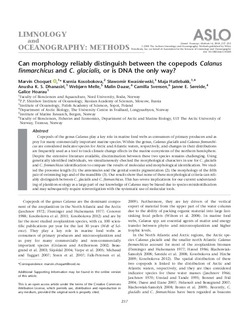| dc.contributor.author | Choquet, Marvin | |
| dc.contributor.author | Kosobokova, Ksenia | |
| dc.contributor.author | Kwaśniewski, Sławomir | |
| dc.contributor.author | Hatlebakk, Maja Karoline Viddal | |
| dc.contributor.author | Dhanasiri, Anusha Krishanthi Shyama | |
| dc.contributor.author | Melle, Webjørn Raunsgård | |
| dc.contributor.author | Daase, Malin | |
| dc.contributor.author | Svensen, Camilla | |
| dc.contributor.author | Søreide, Janne | |
| dc.contributor.author | Hoarau, Galice Guillaume | |
| dc.date.accessioned | 2018-07-25T10:44:24Z | |
| dc.date.available | 2018-07-25T10:44:24Z | |
| dc.date.created | 2018-02-21T16:34:21Z | |
| dc.date.issued | 2018 | |
| dc.identifier.citation | Limnology and Oceanography : Methods. 2018, 16 (4), 237-252. | |
| dc.identifier.issn | 1541-5856 | |
| dc.identifier.uri | http://hdl.handle.net/11250/2506422 | |
| dc.description.abstract | Copepods of the genus Calanus play a key role in marine food webs as consumers of primary producers and as prey for many commercially important marine species. Within the genus, Calanus glacialis and Calanus finmarchi- cus are considered indicator species for Arctic and Atlantic waters, respectively, and changes in their distributions are frequently used as a tool to track climate change effects in the marine ecosystems of the northern hemisphere. Despite the extensive literature available, discrimination between these two species remains challenging. Using genetically identified individuals, we simultaneously checked the morphological characters in use for C. glacialis and C. finmarchicus identification to compare the results of molecular and morphological identification. We stud- ied the prosome length (1); the antennules and the genital somite pigmentation (2); the morphology of the fifth pair of swimming legs and of the mandible (3). Our results show that none of these morphological criteria can reli- ably distinguish between C. glacialis and C. finmarchicus . This has severe implications for our current understand- ing of plankton ecology as a large part of our knowledge of Calanus may be biased due to species misidentification and may subsequently require reinvestigation with the systematic use of molecular tools. | |
| dc.language.iso | eng | |
| dc.title | Can morphology reliably distinguish between the copepods Calanus finmarchicus and C. glacialis, or is DNA the only way? | |
| dc.title.alternative | Can morphology reliably distinguish between the copepods Calanus finmarchicus and C. glacialis, or is DNA the only way? | |
| dc.type | Peer reviewed | |
| dc.type | Journal article | |
| dc.description.version | publishedVersion | |
| dc.source.pagenumber | 237-252 | |
| dc.source.volume | 16 | |
| dc.source.journal | Limnology and Oceanography : Methods | |
| dc.source.issue | 4 | |
| dc.identifier.doi | 10.1002/lom3.10240 | |
| dc.identifier.cristin | 1567686 | |
| dc.relation.project | Norges forskningsråd: 226417 | |
| dc.relation.project | Andre: Russian Foundation for Basic Research (15-29-02447) | |
| dc.relation.project | EC/FP7/264933 | |
| dc.relation.project | Andre: Russian Foundation for Basic Research (16-04-00375) | |
| dc.relation.project | Andre: Pol-Nor/201992/93/2014 | |
| dc.relation.project | Andre: Russian Scientific Foundation (14-50-00095) | |
| dc.relation.project | Norges forskningsråd: 216578 | |
| dc.relation.project | Norges forskningsråd: 227139 | |
| dc.relation.project | Norges forskningsråd: 246747 | |
| cristin.unitcode | 7431,22,0,0 | |
| cristin.unitname | Plankton | |
| cristin.ispublished | true | |
| cristin.fulltext | original | |
| cristin.qualitycode | 1 | |
